Nova Scotia
Wild Flora Society
Ericaceae: Empetrum nigrum L.
(black crowberry)
Empetrum nigrim is one of three crowberries in Nova Scotia; others are Empetrum eamesii (rockberry) and Corema conradii (broom crowberry).1 They are low, evergreen shrubs with small, needle-like ericoid leaves and reduced, wind-pollinated flowers. E nigrum has a creeping growth habit with trailing branches, on some sites growing somewhat erect to 10-30 cm height. Flowers are solitary or few in axils of leaves. Plants in Nova Scotia are usually bisexual.2 Flowers open in spring.3 The fruit is a berry-like drupe with 6-9 nutlets. E. nigrum is common in bogs, barrens, sea cliffs and headlands of Nova Scotia; it is described as preferring cooler moister sites4, but as intolerant of prolonged flodding.5 The species is circumpolar; in North America it occurs in Alaska and in all provinces and territories of Canada except the Yukon. It occurs on the eastern U.S. seaboard down to New Jersey, west to Minnesota, and also on the west coast of the U.S.
Sources | Notes & Refs | Selected Web Resources | Line Drawing
Click on images for larger versions.
|
Febuary 11, 2007. Halifax County: Granite barrens near West Dover. Photographer: JackPine. |
|
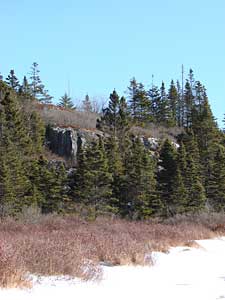
E. nigrum occurred on the lower, partially sheltered rock ledge; on higher, more exposed areas, Corema conradii replaced E. nigrum. Top right: E. nigrum with reindeer and rock tripe lichens, huckleberry (Gaylussaccia baccata) in the background. Bottom right: similar, but reindeer lichen is absent and common juniper (Juniper commune) present above E. nigrum. |
  |
| April 28, 2009. Chebucto Head Photographer: JackPine. Notes | |
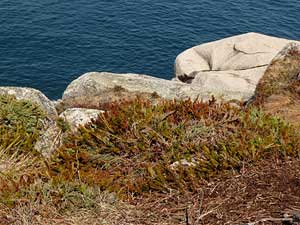
Habitat | 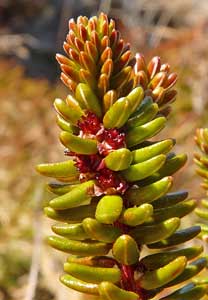 Female flowers |
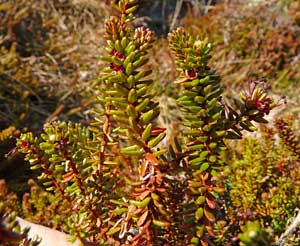 | Left: male and female plants in close proximity (but not on the same shoot). |
 Male flowers opening |  Expanded male flowers |
|
July 5, 2008. Chebucto Head Photographer: JackPine. |
|
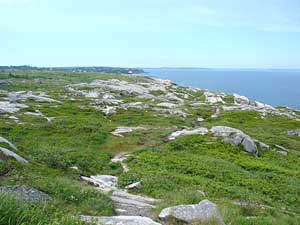
Barrens habitat. |
 Interspersed with Gaylussacia dumosa. |
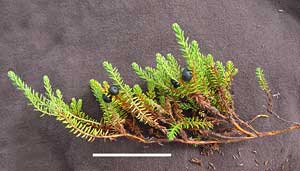 Habit. Bar is 5 cm. |
 Empetrum rubrum, left; E. nigrum, right; portion of branch with upper surfaces of leaves showing (mostly). |
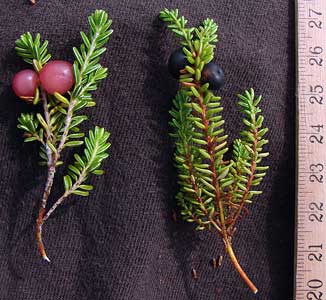 As at left, lower surfaces (mostly). |
|
July 8, 2006. Halifax County: Polly's Cove Photographer: JackPine. |
|
 hummocky bog |
 Empetrum nigrum forms a matrix in this assemblage of species on the side of a hummock . |
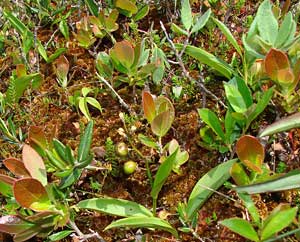 Wetter area than above; E. nigrum not as dense. |
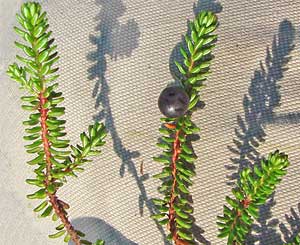 Plant from barrens in fruit. |
|
Aug. 18 , 2006. Halifax County: Polly's Cove Photographer: JackPine. |
|
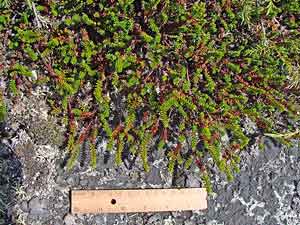 E. nigrum on granite outcrop. |
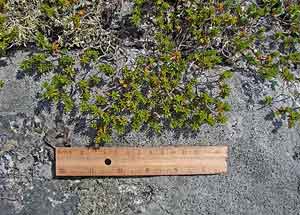 Corema conradii on same outcrop. |
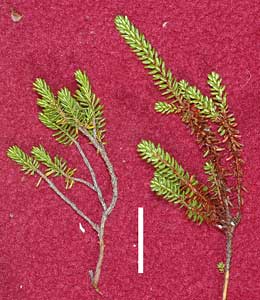 Corema conradii |
Where E. nigrum and C. conradii occurred in proximity, E. nigrum was always in the lower sections which likely remain moist for longer periods after precipitation. Vegetative plants of E. nigrum and C. conradii can sometimes be tricky to identify as one or the other species when they occur singly in these exposed granite outcrops. See Three Crowberries. |
|
Sep. 22, 2005. Halifax County: Polly's Cove. Photographer: JackPine. |
|
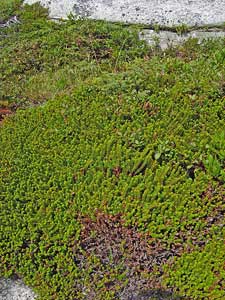 Carpet of E. nigrum on exposed headland. |
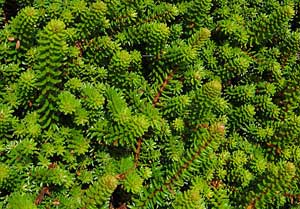 |
|
Dec. 2, 2008. Halifax County: Chebucto Head. Photographer: JackPine. Notes |
|
 |
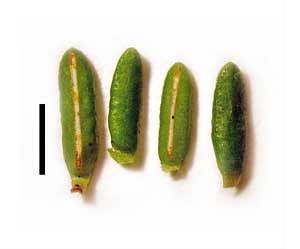 Left: Twigs. Bar is 5 mm. |
 Habitat: E. nigrum occurs on the lower part of slope with Juniperus horizontalis & Vaccinium macrocarpon. E. eamesii occurs with J. horizontalis on upper part of slope. Details.. |
 |
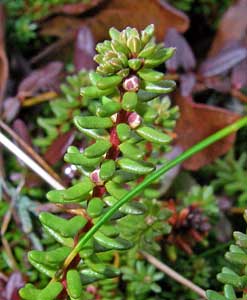 |
 Shoot with flower buds (left). Habitat (above): lower lying area by the sea. |
 |
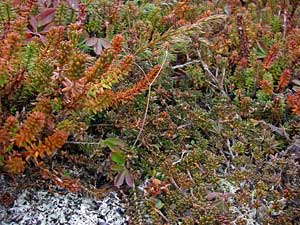 |
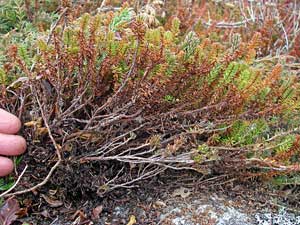 |
Above, left: Habitat - On Large erratic with Empetrum eamesii & Juniperus commune. Details. Above: At the junction with E. eamesii.. Below: Mat of E. nigrum lifted up. |
- Taxonomic Status (ITIS) Copy the species name above and paste it into a form on this ITIS Canada page to confirm the nomenclature and list synonyms.
- NatureServe Explorer Copy the species name above and paste it into a form on this page to view a map of its distribution within North America and its conservation status by province and state.
- Fire Effects Information System: Empetrum nigrum
Notes & References
- A recent revison of Ericaceae places the crowberries, formerly included in the family Empetraceae, in the family Ericaeae,subfamily Ericoideae, tribe Empetrea. See Kron, K.A. et al. 1992. Phylogenetic classification of Ericaceae: molecular and morphological evidence. The Botanical Review 68(3): 335-423.
- There are two subspecies of E. nigrum: Empetrum nigrum ssp. nigrum L. and Empetrum nigrum ssp. hermaphroditum (Lange ex Hagerup) Bcher. These are respectively diploid (2n=26)/dioecious and tetraploid (2n=52)/usually bisexual (hermaphroditic). Both subspecies occur in Europe. An extensive study by Love and Love (1959) revealed only the tetraploid Empetrum nigrum ssp. hermaphroditum in North America; they reported that flowers on the North American plants are predominantly hermaphroditic but that monoecious and polygamous plants are sometimes observed. To complicate matters, Roland and Smith (1969) comment: "The plants around Halifax, at least, seem to be dioecious and it would seem desirable to have more chromosome counts on our material."
Love, A. & Love, D. 1961. Biosystematics of the black crowberries of America. Canadian Journal of Genetics & Cytology 1: 34-38.
Roland, A.E & Smith, E.C. 1969. The flora of Nova Scotia. The Nova Scotia Museum, Halifax, Nova Scotia. - Flowering in Nova Scotia is cited as July to September in the Flora of Nova Scotia, 3rd ed., however this likely refers to appearance of fruits. "Spring" or spring months are cited for flowering at sites in Quebec and Newfoundland: Morin, H. & Payette, S. 1988. Buried seed populations in the montane, subalpine, and alpine belts of Mont Jacques-Cartier, Quebec. Canadian Journal of Botany. 66: 101-107; Mauder, J. A Digital Flora of Newfoundland and Labrador Vascular Plants. Ericaceae: Heath Family ["Empetraceae Section": Crowberries] (http://www.digitalnaturalhistory.com/flora_empetraceae_index.htm, accessed 25 Nov. 2008)
- Crawford, R.M.M. 2008. Plants at the margin: ecological limits and climate change. Cambridge Uiversity Press, p. 312.
- Matthews, R. F. 1992. Empetrum nigrum. In: Fire Effects Information System, [Online]. U.S. Department of Agriculture, Forest Service, Rocky Mountain Research Station, Fire Sciences Laboratory (Producer). Available: http://www.fs.fed.us/database/feis/ [2008, December 14].